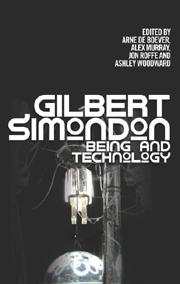Book contents
- Frontmatter
- Contents
- Abbreviations
- Editors' Introduction: Simondon, Finally
- 1 Technical Mentality
- Explications
- 2 ‘Technical Mentality’ Revisited: Brian Massumi on Gilbert Simondon
- 3 Identity and Individuation: Some Feminist Reflections
- 4 Crystals and Membranes: Individuation and Temporality
- Implications
- Resonances
- Glossary: Fifty Key Terms in the Works of Gilbert Simondon
- Notes on Contributors
- Index
3 - Identity and Individuation: Some Feminist Reflections
from Explications
Published online by Cambridge University Press: 12 September 2012
- Frontmatter
- Contents
- Abbreviations
- Editors' Introduction: Simondon, Finally
- 1 Technical Mentality
- Explications
- 2 ‘Technical Mentality’ Revisited: Brian Massumi on Gilbert Simondon
- 3 Identity and Individuation: Some Feminist Reflections
- 4 Crystals and Membranes: Individuation and Temporality
- Implications
- Resonances
- Glossary: Fifty Key Terms in the Works of Gilbert Simondon
- Notes on Contributors
- Index
Summary
There are, for Gilbert Simondon, many kinds of individualities, many kinds of subject, many kinds of object, but all share the processes of individuation, which may serve equally to explain the coming into being and the existence of beings of all kinds, material, organic, human, cosmic. Individuations are the processes that distinguish between inorganic and organic existences, between cultural and technological orders, between objects and subjects, as well as what enables these terms to be linked. His understanding of the processes of genesis of individualities of all kinds has surprising implications not only for philosophies of technology, but also for forms of feminist, anti-racist and radical political thought. In providing models for understanding how things, including living beings, are brought into existence as cohesive individuals, Simondon opens up new ways of understanding identity, transformation and creation – all central ingredients in a radical reconceptualization of thought.
I want to discuss here how physical and biological individuals come to be, and what processes of becoming are involved in their genesis. What orders and materials – conceptual, natural, technological – are involved in the generation of individuality? What forces are at work forming, deforming and transforming individuality such that we can understand the forms of power, and the forces of resistance, that both enable and limit individuals? Can Simondon provide feminist and other modes of radical political thought with a different model by which to understand the concept of identity, not through a notion of the self-same, but through what is radically disparate and continually changing?
- Type
- Chapter
- Information
- Gilbert SimondonBeing and Technology, pp. 37 - 56Publisher: Edinburgh University PressPrint publication year: 2012

